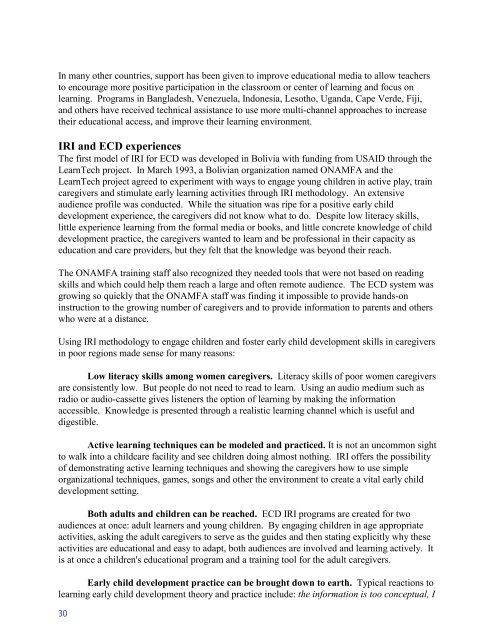SITE VISIT - Consultative Group on Early Childhood Care and ...
SITE VISIT - Consultative Group on Early Childhood Care and ...
SITE VISIT - Consultative Group on Early Childhood Care and ...
You also want an ePaper? Increase the reach of your titles
YUMPU automatically turns print PDFs into web optimized ePapers that Google loves.
In many other countries, support has been given to improve educati<strong>on</strong>al media to allow teachers<br />
to encourage more positive participati<strong>on</strong> in the classroom or center of learning <strong>and</strong> focus <strong>on</strong><br />
learning. Programs in Bangladesh, Venezuela, Ind<strong>on</strong>esia, Lesotho, Ug<strong>and</strong>a, Cape Verde, Fiji,<br />
<strong>and</strong> others have received technical assistance to use more multi-channel approaches to increase<br />
their educati<strong>on</strong>al access, <strong>and</strong> improve their learning envir<strong>on</strong>ment.<br />
IRI <strong>and</strong> ECD experiences<br />
The first model of IRI for ECD was developed in Bolivia with funding from USAID through the<br />
LearnTech project. In March 1993, a Bolivian organizati<strong>on</strong> named ONAMFA <strong>and</strong> the<br />
LearnTech project agreed to experiment with ways to engage young children in active play, train<br />
caregivers <strong>and</strong> stimulate early learning activities through IRI methodology. An extensive<br />
audience profile was c<strong>on</strong>ducted. While the situati<strong>on</strong> was ripe for a positive early child<br />
development experience, the caregivers did not know what to do. Despite low literacy skills,<br />
little experience learning from the formal media or books, <strong>and</strong> little c<strong>on</strong>crete knowledge of child<br />
development practice, the caregivers wanted to learn <strong>and</strong> be professi<strong>on</strong>al in their capacity as<br />
educati<strong>on</strong> <strong>and</strong> care providers, but they felt that the knowledge was bey<strong>on</strong>d their reach.<br />
The ONAMFA training staff also recognized they needed tools that were not based <strong>on</strong> reading<br />
skills <strong>and</strong> which could help them reach a large <strong>and</strong> often remote audience. The ECD system was<br />
growing so quickly that the ONAMFA staff was finding it impossible to provide h<strong>and</strong>s-<strong>on</strong><br />
instructi<strong>on</strong> to the growing number of caregivers <strong>and</strong> to provide informati<strong>on</strong> to parents <strong>and</strong> others<br />
who were at a distance.<br />
Using IRI methodology to engage children <strong>and</strong> foster early child development skills in caregivers<br />
in poor regi<strong>on</strong>s made sense for many reas<strong>on</strong>s:<br />
Low literacy skills am<strong>on</strong>g women caregivers. Literacy skills of poor women caregivers<br />
are c<strong>on</strong>sistently low. But people do not need to read to learn. Using an audio medium such as<br />
radio or audio-cassette gives listeners the opti<strong>on</strong> of learning by making the informati<strong>on</strong><br />
accessible. Knowledge is presented through a realistic learning channel which is useful <strong>and</strong><br />
digestible.<br />
Active learning techniques can be modeled <strong>and</strong> practiced. It is not an uncomm<strong>on</strong> sight<br />
to walk into a childcare facility <strong>and</strong> see children doing almost nothing. IRI offers the possibility<br />
of dem<strong>on</strong>strating active learning techniques <strong>and</strong> showing the caregivers how to use simple<br />
organizati<strong>on</strong>al techniques, games, s<strong>on</strong>gs <strong>and</strong> other the envir<strong>on</strong>ment to create a vital early child<br />
development setting.<br />
Both adults <strong>and</strong> children can be reached. ECD IRI programs are created for two<br />
audiences at <strong>on</strong>ce: adult learners <strong>and</strong> young children. By engaging children in age appropriate<br />
activities, asking the adult caregivers to serve as the guides <strong>and</strong> then stating explicitly why these<br />
activities are educati<strong>on</strong>al <strong>and</strong> easy to adapt, both audiences are involved <strong>and</strong> learning actively. It<br />
is at <strong>on</strong>ce a children's educati<strong>on</strong>al program <strong>and</strong> a training tool for the adult caregivers.<br />
<strong>Early</strong> child development practice can be brought down to earth. Typical reacti<strong>on</strong>s to<br />
learning early child development theory <strong>and</strong> practice include: the informati<strong>on</strong> is too c<strong>on</strong>ceptual, I<br />
30
















